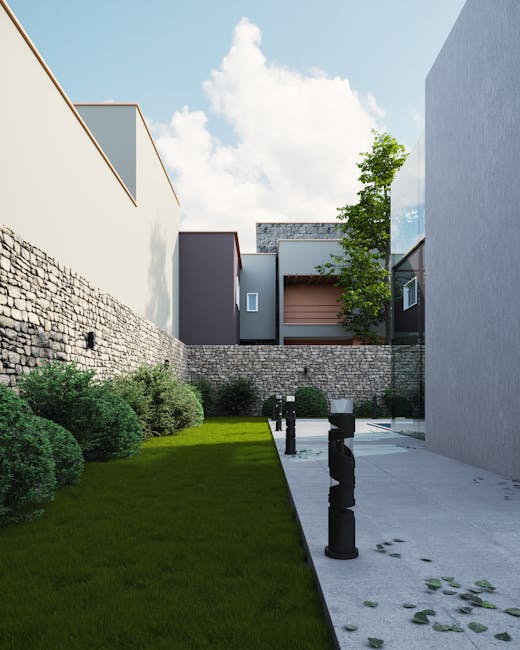Minimalist Outdoor Spaces: Bringing Modern Design Principles into the Garden and Patio
Introduction
In today’s fast-paced world, finding serenity and simplicity has become paramount. Extending the minimalist aesthetic beyond our homes and into our outdoor spaces – gardens, patios, balconies – offers a refuge from the clutter. A minimalist outdoor space isn’t just about empty space; it’s about thoughtfully curated elements that create a sense of calm, order, and connection with nature. This article explores how to bring modern design principles into your garden and patio, transforming them into havens of tranquility.
Key Principles of Minimalist Outdoor Design
Less is More: Decluttering Your Space
The cornerstone of minimalism is decluttering. This involves removing unnecessary items, focusing on essential elements, and creating a visually clean environment. Consider these steps:
- Identify and Remove: Walk through your outdoor space and honestly assess each item. Is it essential? Does it bring you joy? If not, consider donating, selling, or discarding it.
- Streamline Furniture: Opt for multi-functional furniture that serves multiple purposes. Think benches with built-in storage or tables that fold away when not in use.
- Hidden Storage: Conceal gardening tools, cushions, and other necessities in discreet storage boxes or built-in compartments.
Embrace Neutral Colors and Natural Materials
Minimalist design favors a calming color palette and the use of natural materials to connect with the outdoors. Consider these approaches:
- Neutral Palette: Stick to a limited color palette of whites, grays, browns, and greens. These colors create a sense of peace and allow the natural beauty of plants to shine.
- Natural Materials: Incorporate materials like wood, stone, concrete, and metal. These materials are durable, aesthetically pleasing, and blend seamlessly with the environment. Think wooden decking, stone pathways, or concrete planters.
- Textural Variety: While sticking to a neutral palette, introduce visual interest through texture. Combine smooth concrete with rough-hewn wood or incorporate pebbles and gravel for contrasting surfaces.
Focus on Functionality and Purpose
Every element in a minimalist outdoor space should serve a purpose. Avoid purely decorative items that add clutter without providing function.
- Define Zones: Create distinct zones for different activities, such as dining, relaxing, or gardening. This helps organize the space and makes it more functional.
- Prioritize Comfort: Choose comfortable and supportive furniture that encourages relaxation. Consider adding cushions and throws for added warmth and comfort.
- Strategic Lighting: Use outdoor lighting to enhance the ambiance and functionality of the space. Opt for simple, elegant fixtures that provide adequate illumination without being overwhelming.
Creating a Minimalist Garden
Simple Plantings and Green Spaces
In a minimalist garden, less is definitely more. Focus on a few carefully chosen plants that create a sense of tranquility and balance.
- Green on Green: Utilize varying shades and textures of green to create visual interest without introducing a riot of colors.
- Structural Plants: Incorporate plants with strong architectural forms, such as grasses, ferns, or succulents, to add structure and definition.
- Limited Variety: Avoid overcrowding your garden with too many different species. Stick to a few well-chosen plants that complement each other.
Hardscaping with Clean Lines
Hardscaping elements like pathways, patios, and walls can play a significant role in creating a minimalist aesthetic.
- Clean and Straight: Opt for clean, straight lines and geometric shapes in your hardscaping design.
- Minimalist Materials: Use materials like concrete, stone, or gravel for pathways and patios. These materials are durable, low-maintenance, and blend seamlessly with the environment.
- Consider Water Features: A simple water feature, such as a minimalist fountain or a small pond, can add a sense of calm and tranquility to your garden.
Designing a Minimalist Patio
Furniture Selection: Quality over Quantity
Choosing the right furniture is crucial for creating a functional and stylish minimalist patio.
- Invest in Quality: Choose high-quality furniture that is durable and weather-resistant. This will ensure that your furniture lasts for years to come.
- Simple Silhouettes: Opt for furniture with clean lines and simple silhouettes. Avoid ornate or overly decorative pieces.
- Consider Comfort: Prioritize comfort when choosing furniture. Choose pieces that are comfortable to sit in and that encourage relaxation.
Accessories and Decor: Intentional and Meaningful
Accessories and decor should be used sparingly and intentionally in a minimalist patio.
- Less is More: Avoid cluttering your patio with too many accessories. Choose a few carefully selected items that add personality and style.
- Natural Elements: Incorporate natural elements like potted plants, stones, or driftwood to connect with the outdoors.
- Personal Touches: Add personal touches that reflect your style and personality, such as a favorite piece of art or a cozy throw blanket.
Conclusion
Creating a minimalist outdoor space is about more than just aesthetics; it’s about creating a sanctuary where you can relax, unwind, and connect with nature. By decluttering, embracing neutral colors and natural materials, focusing on functionality, and carefully selecting plants and furniture, you can transform your garden and patio into a haven of tranquility. Embrace the principles of less is more, and create an outdoor space that reflects your personal style and promotes a sense of calm and well-being.














Post Comment